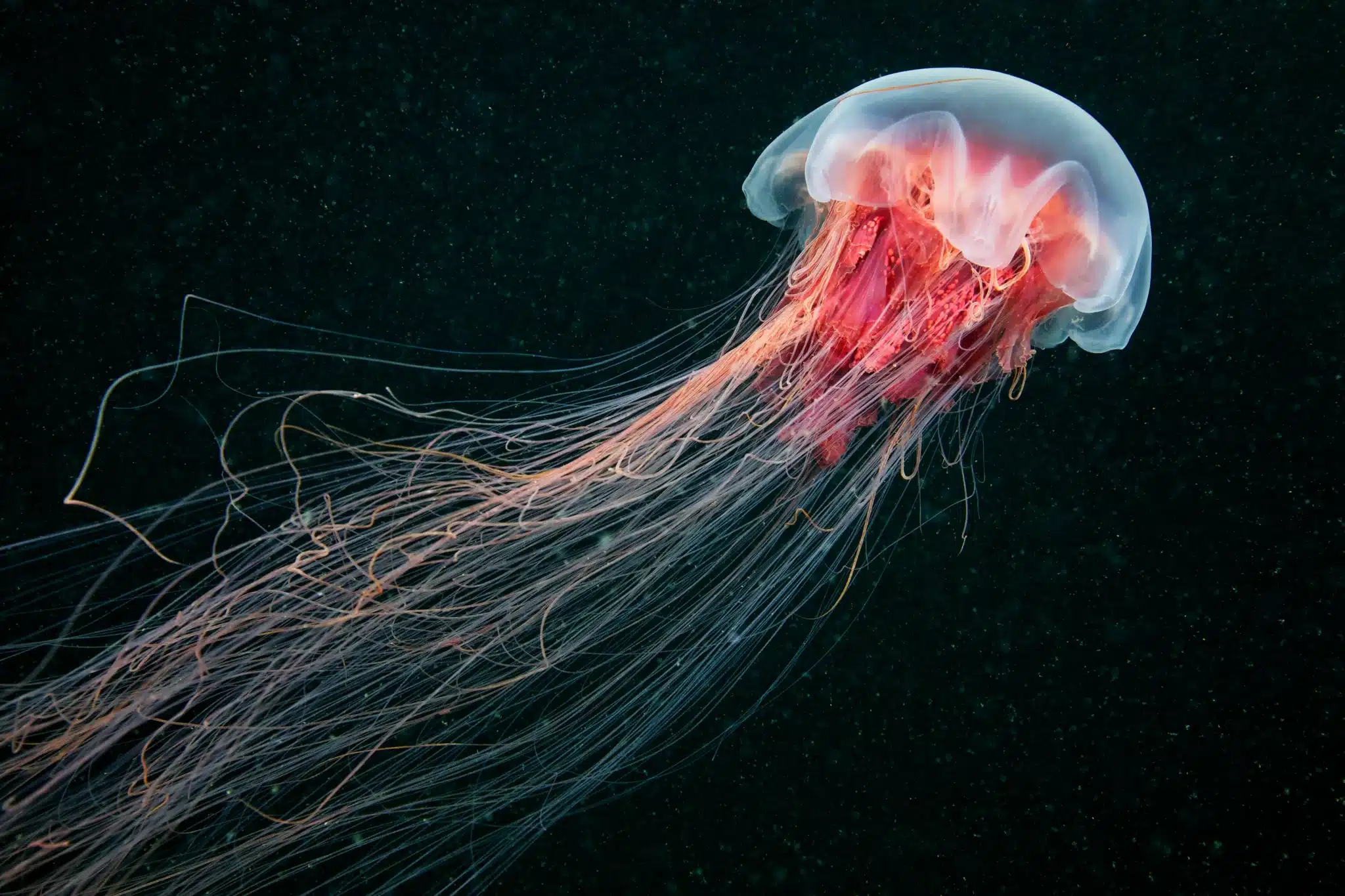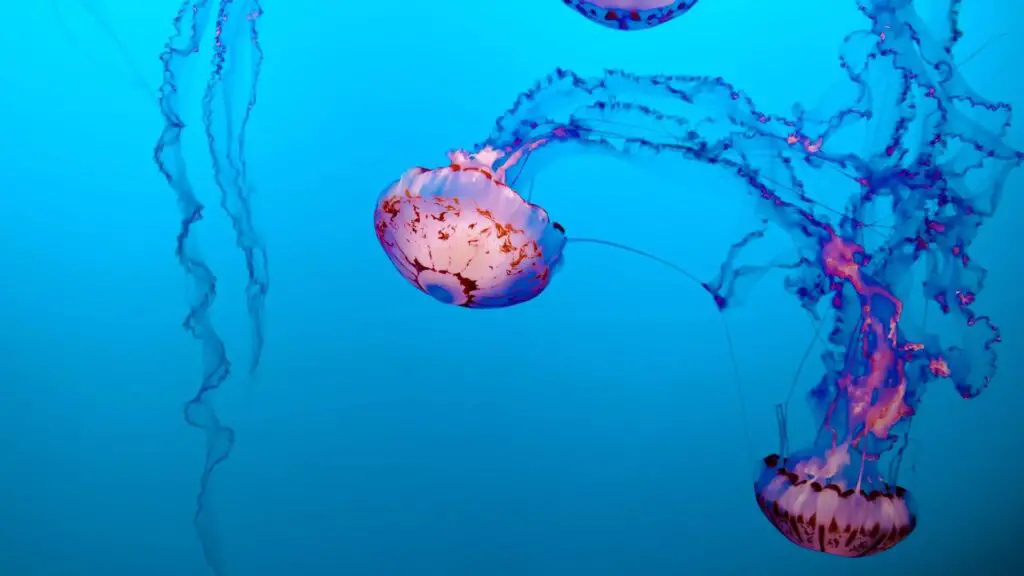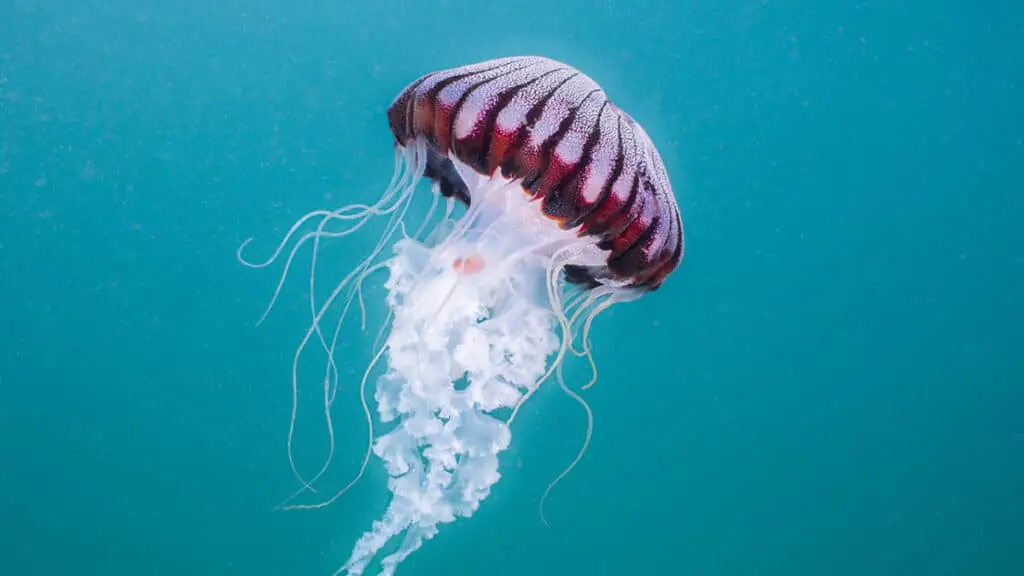Why Are Jellyfish Important

Introduction
Why Are Jellyfish Important: Jellyfish, often regarded as mysterious and sometimes even menacing creatures of the sea, hold a vital place in the intricate tapestry of our marine ecosystems. While their ethereal appearance and seemingly passive nature might mislead casual observers, these gelatinous beings serve essential roles that reverberate throughout the world’s oceans. This introduction explores the significance of jellyfish in the broader context of marine biology and environmental science.
At first glance, jellyfish may appear as mere drifters, propelled aimlessly by ocean currents. However, their importance becomes evident when we delve deeper into their ecological contributions. These gelatinous organisms are voracious predators, feeding on a wide range of planktonic organisms, including small fish and crustaceans. By controlling the populations of these prey species, jellyfish help maintain the delicate balance of marine food webs.
Beyond their role as top-level predators, jellyfish also offer valuable insights into the health of marine environments. Their population fluctuations can serve as indicators of ecosystem shifts and environmental changes, including rising sea temperatures and pollution. Scientists study jellyfish blooms to monitor these changes and gain a better understanding of the impact of climate change on our oceans.
In this exploration of jellyfish’s importance, we will delve into their ecological significance, their influence on global ecosystems, and the invaluable knowledge they provide to scientists studying the health of our oceans. Understanding the crucial role of jellyfish sheds light on the complex web of life beneath the ocean’s surface and underscores the urgency of protecting these fragile ecosystems.

Why are jellyfish useful to humans?
Certain species of jellyfish are not only safe to eat but also a good source of several nutrients, including protein, antioxidants, and minerals like selenium and choline. The collagen found in jellyfish may also contribute to health benefits like reduced blood pressure.
Jellyfish, though often misunderstood or even feared by humans, do offer utility and relevance to our species. Firstly, their biological properties have piqued the interest of researchers in various fields. Some species of jellyfish exhibit bioluminescence, which has inspired studies in biotechnology and could potentially lead to advancements in medical imaging and genetic research. Additionally, their unique cellular and molecular mechanisms, such as their remarkable regenerative abilities, hold promise for future biomedical applications, including tissue repair and organ transplantation.
Jellyfish have culinary value in certain cultures. In parts of Asia, they are considered a delicacy and are used in traditional dishes. They are a source of protein and nutrients, contributing to local diets and economies. However, it’s essential to ensure sustainable harvesting practices to prevent overexploitation and maintain healthy jellyfish populations.
Jellyfish also play a role in the tourism industry, as their presence can attract visitors interested in observing these captivating creatures in their natural habitat. This can boost local economies in coastal regions that rely on tourism revenue.
While jellyfish may not have direct and widespread use in our daily lives, their unique attributes and contributions in various scientific, culinary, and tourism contexts illustrate their usefulness and importance to humans.
What is the role of the jellyfish in the world?
Jellyfish are an important food source for other marine organisms including sea turtles, sunfish and spade fish. Studies have also suggested that after dying, jellyfish act as an important food source to organisms living in the deep depths of the ocean.
Jellyfish, often considered enigmatic inhabitants of the world’s oceans, play several significant roles in marine ecosystems. Firstly, they function as both predator and prey, occupying various levels of the food chain. Jellyfish feed on small fish, plankton, and other microscopic organisms, helping to control their populations. By doing so, they play a crucial role in maintaining the balance of marine ecosystems, preventing certain species from overpopulating and potentially disrupting the delicate ecological equilibrium.
Additionally, jellyfish themselves serve as a food source for numerous marine animals, including sea turtles, certain fish species, and seabirds. Their availability as prey helps sustain the populations of these predators, contributing to the overall biodiversity of the oceans.
Beyond their ecological roles, jellyfish also act as environmental indicators. Their population dynamics and the occurrence of jellyfish blooms can signal changes in ocean conditions, such as rising sea temperatures or pollution. Scientists study these phenomena to gain insights into the health of marine environments and the effects of climate change on our oceans.
Jellyfish are integral components of marine ecosystems, contributing to both the structure and function of these intricate systems. Their multifaceted roles as predators, prey, and environmental indicators highlight their significance in maintaining the health and balance of the world’s oceans.
What are 3 interesting facts about jellyfish?
Fascinating facts about jellyfish
- Jellyfish are 95% water. Surprisingly, jellyfish are mostly made up of water, not jelly.
- Jellyfish are a type of ‘cnidarian’, which is named after the Greek word for “sea nettle”
- They have very short lifespans.
- Some jellyfish can turn back their biological clock.
Jellyfish are fascinating creatures with several intriguing characteristics that set them apart in the animal kingdom. Here are three interesting facts about jellyfish:
Ancient Survivors: Jellyfish have been around for an incredibly long time, with a lineage dating back over 500 million years. They predate dinosaurs and even some of the earliest vertebrates. Their evolutionary success is a testament to their adaptability and resilience in the ever-changing marine environments.
Bioluminescent Beauties: Many jellyfish species possess the remarkable ability to produce bioluminescent light. This light is created by special cells called photophores, which emit a beautiful glow when disturbed. This bioluminescence serves multiple purposes, including attracting prey, deterring predators, and potentially communicating with other jellyfish.
Ageless Wonders: Jellyfish are one of the few creatures on Earth that display a unique biological trait known as “immortality.” Some species, like the Turritopsis dohrnii, have the remarkable ability to revert to an earlier life stage after reaching maturity. This process, known as transdifferentiation, allows them to essentially start their life cycle anew, potentially making them biologically immortal.
These intriguing facts not only highlight the longevity and adaptability of jellyfish but also their captivating qualities that continue to captivate scientists and nature enthusiasts alike.
Why are jellyfish important?
Jellyfish are an essential part of many food chains. By feeding on smaller creatures such as fish larvae and eggs, jellyfish help to control species’ populations and maintain the balance of the ocean’s ecosystem. As well as eating other animals, jellyfish are often prey themselves – even for other jellyfish!
Jellyfish, often misunderstood and sometimes feared, play a crucial role in marine ecosystems, making them important for several reasons. Firstly, they are a source of food for many marine creatures, including sea turtles, some fish species, and even other jellyfish. Their presence in the food web ensures the survival and balance of various species within the oceanic ecosystem.
Moreover, jellyfish help regulate the population of small planktonic organisms. When jellyfish feed on these plankton, they prevent them from overpopulating and disrupting the delicate equilibrium of the marine food chain. This control is vital in maintaining the health and diversity of marine life.
Additionally, jellyfish act as indicators of the health of the oceans. Their population fluctuations can signal changes in water quality and temperature, as well as shifts in the overall ecosystem. Monitoring jellyfish populations can provide valuable insights into the impacts of climate change and pollution on marine environments.
Jellyfish are not just ethereal and intriguing creatures of the sea; they are vital components of marine ecosystems, contributing to biodiversity, ecological balance, and scientific discovery. Understanding their importance is essential for the conservation and preservation of our oceans.
How long can a jellyfish live?
2-3 years
Most jellyfish are short lived. Medusa or adult jellyfish typically live for a few months, depending on the species, although some species can live for 2-3 years in captivity. Polyps can live and reproduce asexually for several years, or even decades.
The lifespan of a jellyfish can vary significantly depending on its species and environmental conditions. While some jellyfish have relatively short lives, measured in just a few hours or days, others can live for several years.
For example, the tiny, transparent jellyfish known as the Turritopsis dohrnii, or “immortal jellyfish,” has gained attention for its unique ability to revert to its juvenile form after reaching maturity. This process, called transdifferentiation, allows it to potentially evade death from old age and theoretically live indefinitely under the right conditions.
On the other hand, many other jellyfish species have relatively short lifespans, often only a few months to a year. Their lives typically consist of a series of stages, including a larval stage, a polyp stage, and a medusa (adult) stage, with each stage having its own duration.
Environmental factors such as water temperature, food availability, and predation also influence the lifespan of jellyfish. Warmer waters and an abundance of food can promote longer lifespans, while adverse conditions or increased predation can lead to shorter lives.
The lifespan of a jellyfish varies widely among species and can range from a few hours to potentially several years, with factors like species type and environmental conditions playing a crucial role in determining their longevity.
Do jellyfish have any environmental benefits?
Jellyfish, often perceived as nuisances or hazards in some coastal areas, do indeed have environmental benefits that contribute to the overall health and balance of marine ecosystems.
- Predator Control: One of the significant roles of jellyfish in the ecosystem is their ability to control populations of small prey species. When jellyfish feed on zooplankton and small fish, they help regulate these populations, preventing overgrazing on phytoplankton. This balance is essential for maintaining the health of marine food chains, as phytoplankton are primary producers at the base of the marine food web.
- Nutrient Cycling: After consuming prey, jellyfish excrete waste rich in nutrients like nitrogen and phosphorus. These nutrients are released back into the water, where they can be absorbed by other marine organisms, promoting nutrient cycling. This process can stimulate primary productivity in the ocean, benefiting a wide range of marine life.
- Indicator Species: The presence and behavior of jellyfish can serve as indicators of environmental changes. Their sensitivity to factors like water temperature, salinity, and pollution make them valuable indicators of ecosystem health. Scientists study jellyfish populations to monitor and assess the impacts of climate change and pollution on marine environments.
- Research and Medicine: Jellyfish have provided valuable insights for scientific research and medicine. Some of their unique proteins and compounds have applications in fields such as cancer research and neuroscience.
While jellyfish may seem like simple and sometimes problematic creatures, they play a crucial role in maintaining the balance and health of marine ecosystems, making them environmentally important in various ways.
Are jellyfish indicators of environmental change?
Jellyfish are increasingly being recognized as potential indicators of environmental change. These gelatinous creatures, with their simple yet efficient biology, can thrive in various marine conditions, making them sensitive to alterations in their ecosystem. Scientists have noted several ways in which jellyfish populations can provide valuable insights into environmental shifts.
Jellyfish are highly responsive to changes in water temperature and quality. Rising sea temperatures, pollution, and changes in ocean currents can influence jellyfish distribution and abundance. Therefore, shifts in jellyfish populations can serve as early warning signs of environmental disturbances.
The proliferation of jellyfish can disrupt marine food webs. Their rapid growth and predation on small fish and plankton can lead to imbalances in marine ecosystems. When jellyfish populations surge, it can indicate disruptions in the delicate balance of oceanic ecosystems.
The stinging cells of jellyfish can pose risks to human activities such as swimming and fishing, highlighting the need to monitor and understand their patterns and behaviors.
Jellyfish can indeed serve as indicators of environmental change due to their sensitivity to alterations in their habitat and their potential to disrupt marine ecosystems. Studying these enigmatic creatures can provide crucial insights into the health of our oceans and the impacts of climate change and pollution.
How can we protect jellyfish and their ecosystems?
Protecting jellyfish and their ecosystems is crucial for maintaining the balance of marine ecosystems and ensuring the health of our oceans. Here are several ways in which we can work towards safeguarding these fascinating creatures and the environments they inhabit.
- Reduce plastic pollution: One of the biggest threats to jellyfish is plastic pollution. Plastic waste in the oceans can entangle jellyfish and disrupt their habitats. By reducing plastic use and properly disposing of it, we can help keep their ecosystems clean.
- Sustainable fishing practices: Overfishing can disrupt the food chain, leading to increased jellyfish populations. Implementing sustainable fishing practices and regulations can help maintain the balance of marine life.
- Protecting coastal habitats: Coastal areas are important breeding and feeding grounds for jellyfish. Preserving these habitats, such as mangroves and seagrass beds, is vital for their survival.
- Climate change mitigation: Rising sea temperatures and ocean acidification are affecting jellyfish populations. By reducing greenhouse gas emissions and supporting climate change mitigation efforts, we can mitigate these impacts.
- Research and monitoring: Continued research into jellyfish ecology and behavior is essential for understanding their ecosystems. Monitoring jellyfish populations and their environmental conditions helps us make informed conservation decisions.
- Educational campaigns: Raising awareness about the importance of jellyfish and their ecosystems can foster public support for conservation efforts and encourage responsible behavior towards the oceans.
By taking these steps, we can contribute to the protection of jellyfish and their ecosystems, ensuring the health and resilience of our oceans for generations to come.

Conclusion
The importance of jellyfish in our marine ecosystems cannot be overstated. These seemingly enigmatic creatures play multifaceted roles that ripple through the intricate web of life beneath the ocean’s surface. As voracious predators, they help maintain the balance of marine food webs by regulating the populations of various planktonic organisms, which in turn affects the entire ecosystem.
Jellyfish act as valuable indicators of environmental health and change. Their population dynamics and the occurrence of jellyfish blooms offer crucial insights into the impacts of climate change, pollution, and habitat degradation on our oceans. Scientists rely on jellyfish data to monitor these shifts, emphasizing the need to protect and conserve these fragile ecosystems.
Jellyfish also have the potential to yield innovative applications in fields like biomedicine and materials science, showcasing their significance beyond ecological roles. Their unique biological features and bioluminescent properties have inspired research with potential benefits for humanity.
The humble jellyfish serves as a sentinel of the oceans, silently signaling the health of our planet’s most vital ecosystems. Recognizing their importance not only enriches our understanding of marine biology but also underscores the urgency of proactive conservation efforts. Preserving jellyfish and their habitats is not merely an ecological imperative but a responsibility for the sustainability of life on Earth.



